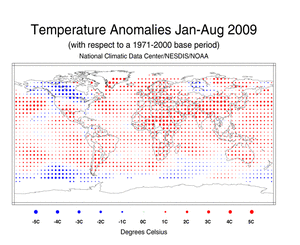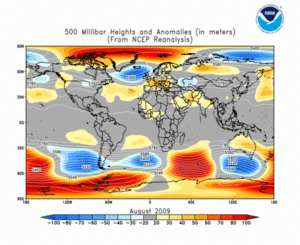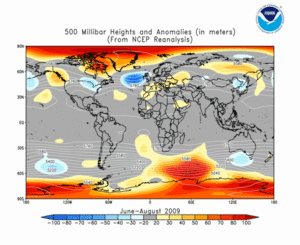Contents of this Section:
Global Highlights
- The combined global land and ocean average surface temperature for August 2009 was 0.62°C (1.12°F) above the 20th century average of 15.6°C (60.1°F). This is the second warmest such value on record, behind 1998. August 2009 was the 31st consecutive August with an average global surface temperature above the 20th century average. The last August with global temperatures below the 20th century average occurred in 1978.
- The combined global land and ocean average surface temperature for June-August 2009 was the third warmest on record for the season, 0.59°C (1.06°F) above the 20th century average of 15.6°C (60.1°F).
- For the year to date, the combined global land and ocean surface temperature of 14.5 °C (58.3 °F) tied with 2003 as the fifth-warmest January-August period on record. This value is 0.55°C (0.99°F) above the 20th century average.
- The worldwide ocean surface temperature for August 2009 was the warmest on record for August, 0.57°C (1.03°F) above the 20th century average of 16.4°C (61.4°F).
- The seasonal (June-August 2009) worldwide ocean surface temperature was also the warmest on record, 0.58°C (1.04°F) above the 20th century average of 16.4°C (61.5°F).
- In the Southern Hemisphere, both the August 2009 average temperature for land areas, and the Hemisphere as a whole (land and ocean surface combined), represented the warmest August on record.
- A weak El Niño persisted across the equatorial Pacific Ocean during August 2009. Consequently, sea surface temperatures across the equatorial Pacific Ocean were between 0.7-1.0°C (1.3-1.8°F) above average during the month. According to NOAA's Climate Prediction Center, El Niño is expected to strengthen and last through the Northern Hemisphere winter 2009-2010.
The data presented in this report are preliminary. Ranks and anomalies may change as more complete data are received and processed. The most current data may be accessed via the Global Surface Temperature Anomalies page.
Introduction
Please Note: Effective with the July 2009 State of the Climate Report, NCDC transitioned to the new version (version 3b) of the extended reconstructed sea surface temperature (ERSST) dataset. ERSST.v3b is an improved extended SST reconstruction over version 2. Most of the improvements are justified by testing with simulated data. The primary difference in version 3b, compared to version 2, is improved low-frequency tuning that increases the sensitivity to data prior to 1930. In ERSST v3b, satellite data was removed from the ERSST product. The addition of satellite data from 1985 to present caused problems for many users. Although the satellite data were corrected with respect to the in situ data, a small residual cold bias remained at high southern latitudes where in situ data were sparse. For more information about the differences between ERSST.v3b and ERSST.v2 please read Summary of Recent Changes in the Land-Ocean Temperature Analyses and Improvements to NOAA's Historical Merged Land-Ocean Surface Temperature Analysis (1880-2006) paper.
Temperature anomalies for August 2009 and June-August 2009 are shown on the dot maps below. The dot maps on the left provide a spatial representation of anomalies calculated from the Global Historical Climatology Network (GHCN) dataset of land surface stations using a 1961-1990 base period. The dot maps on the right are a product of a merged land surface and sea surface temperature (SST) anomaly analysis developed by Smith et al. (2008). Temperature anomalies with respect to the 1961-1990 average for land and ocean are analyzed separately and then merged to form the global analysis.
August 2009
The combined global land and ocean surface temperatures for August 2009 ranked as the second warmest August on record since records began in 1880. The combined global land and ocean temperature anomaly was 0.62°C (1.12°F), falling only 0.05°C (0.09°F) short of tying the record set in 1998. Sea surface temperatures (SST) during August 2009 were warmer than average across much of the world's oceans, with cooler-than-average conditions across the higher-latitude southern oceans and the northern parts of the Pacific and Atlantic oceans. The August 2009 worldwide ocean SST ranked as the warmest on record for a third consecutive month—0.57°C (1.03°F) above the 20th century average of 15.6°C (60.1°F). This broke the previous August record set in 1998, 2003, and 2005.
Meanwhile, the worldwide land surface temperature represented the fourth warmest August on record. During the month of August, warmer-than-average temperatures were present across large portions of the world's land areas with the exception of cooler-than-average conditions across Japan, the central contiguous United States, parts of Canada, western Alaska, and western Russia.
In the Southern Hemisphere, both the August 2009 average temperature for land areas, and the Hemisphere as a whole (land and ocean surface combined), represented the warmest August on record.
According to the Australian Bureau of Meteorology (BoM), Australia had its warmest August since national temperature records began 60 years ago. Temperatures ranged from 2-6°C (4-11°F) above average across the nation. The August 2009 average temperature for the nation as a whole was 2.47°C (4.45°F) above the 1961-1990 average, shattering the previous record by 0.98°C (1.76°F). In addition to the Australian mean temperature record, Australia's maximum temperature anomaly for August 2009 was 3.20°C (5.76°F), surpassing the previous record of 3.11°C (5.60°F) set in April 2005. Additionally, the maximum temperatures for all of Australia's states (with the exception of Tasmania) ranked in the top five, with Queensland and the Northern Territory having their highest August maximum temperatures.
According to the New Zealand's National Institute of Water and Atmospheric Research (NIWA), New Zealand experienced anomalously warm conditions during August 2009, resulting in the warmest August since national records began 155 years ago. The national average temperature of 10.2°C (50.4°F) was 1.7°C (3.1°F) above the August average. It was reported that the highest temperature recorded during August 2009 was 25.5°C (77.9°F), observed at Henderson (Auckland) on August 11th.
A weak El Niño persisted across the equatorial Pacific Ocean during August 2009. Consequently, sea surface temperatures across the equatorial Pacific Ocean were between 0.7-1.0°C (1.3-1.8°F) above average during the month. If El Niño continues to mature as projected by NOAA, global temperatures are likely to continue to threaten previous record highs. Please see the August 2009 ENSO discussion for additional information.
Season (June-August)
The combined global land and ocean surface temperature during June-August 2009 was the third warmest on record, behind 1998 and 2005. During the season, warmer-than-average temperatures engulfed much of the planet's surface, with the exception of cooler-than-average conditions across most of the northern contiguous U.S., the southern oceans, northern Atlantic Ocean, and parts of Canada, southeastern South America, and central and eastern Asia. The seasonal temperature for the worldwide ocean surface ranked as the warmest on record—0.58°C (1.04°F) above the 20th century average.
According to the Australian Bureau of Meteorology (BoM), the austral winter (June-August) was anomalously warm. The national average during the season was 1.33°C (2.39°F) above the 1961-1990 average. This was 0.01°C (0.02°F) shy of the record set in 1996. However, New South Wales, Victoria, and South Australia set new state seasonal mean temperatures.
Year-to-date (January-August)
The  January-August 2009 map of temperature anomalies shows the presence of warmer-than-average conditions across much of the globe's surface area, with the exception of cooler-than-average conditions across Canada, parts of the northern contiguous United States, the southern oceans, and along the eastern North Pacific Ocean. The combined global land and ocean surface temperature for the year-to-date period tied with 2003 as the fifth warmest January-August period on record. This value is 0.55°C (0.99°F) above the 20th century average.
January-August 2009 map of temperature anomalies shows the presence of warmer-than-average conditions across much of the globe's surface area, with the exception of cooler-than-average conditions across Canada, parts of the northern contiguous United States, the southern oceans, and along the eastern North Pacific Ocean. The combined global land and ocean surface temperature for the year-to-date period tied with 2003 as the fifth warmest January-August period on record. This value is 0.55°C (0.99°F) above the 20th century average.
The average position of the upper-level ridges of high pressure and troughs of low pressure (depicted by positive and negative 500-millibar height anomalies on the  August 2009 map and
August 2009 map and  June-August 2009, respectively) are generally reflected by areas of positive and negative temperature anomalies at the surface, respectively. For other Global products, please see the Climate Monitoring Global Products page.
June-August 2009, respectively) are generally reflected by areas of positive and negative temperature anomalies at the surface, respectively. For other Global products, please see the Climate Monitoring Global Products page.
Images of sea surface temperature conditions are available for all weeks during 2009 from the weekly SST page.
Temperature Rankings and Graphics
Current Month | Seasonal | Year-to-date
| August | Anomaly | Rank (out of 130 years) | (Next) Warmest on Record | ||||
|---|---|---|---|---|---|---|---|
| °C | °F | Year | °C | °F | |||
| Global | |||||||
| Land | +0.74 | +1.33 | 4th warmest | 1998 | +0.95 | +1.71 | |
| Ocean | +0.57 | +1.03 | Warmest | (2005)* | +0.56 | +1.01 | |
| Land and Ocean | +0.62 | +1.12 | 2nd warmest | 1998 | +0.67 | +1.21 | |
| Northern Hemisphere | |||||||
| Land | +0.61 | +1.10 | 10th warmest* | 1998 | +0.96 | +1.73 | |
| Ocean | +0.61 | +1.10 | 3rd warmest | 2005* | +0.64 | +1.15 | |
| Land and Ocean | +0.61 | +1.10 | 6th warmest* | 2003 | +0.72 | +1.30 | |
| Southern Hemisphere | |||||||
| Land | +1.11 | +2.00 | Warmest | (1998) | +0.90 | +1.62 | |
| Ocean | +0.56 | +1.01 | 2nd warmest | 1998 | +0.57 | +1.03 | |
| Land and Ocean | +0.64 | +1.15 | Warmest | (1998) | +0.62 | +1.12 | |
*Signifies a tie
| June–August | Anomaly | Rank (out of 130 years) | (Next) Warmest on Record | ||||
|---|---|---|---|---|---|---|---|
| °C | °F | Year | °C | °F | |||
| Global | |||||||
| Land | +0.64 | +1.15 | 8th warmest | 1998 | +0.92 | +1.66 | |
| Ocean | +0.58 | +1.04 | Warmest | (1998) | +0.57 | +1.03 | |
| Land and Ocean | +0.59 | +1.06 | 3rd warmest | 1998 | +0.67 | +1.21 | |
| Northern Hemisphere | |||||||
| Land | +0.60 | +1.08 | 10th warmest | 1998 | +0.94 | +1.69 | |
| Ocean | +0.62 | +1.12 | 2nd warmest | 2005 | +0.63 | +1.13 | |
| Land and Ocean | +0.61 | +1.10 | 4th warmest | 2005* | +0.70 | +1.26 | |
| Southern Hemisphere | |||||||
| Land | +0.76 | +1.37 | 3rd warmest | 1998 | +0.88 | +1.58 | |
| Ocean | +0.55 | +0.99 | 2nd warmest | 1998 | +0.59 | +1.06 | |
| Land and Ocean | +0.58 | +1.04 | 2nd warmest | 1998 | +0.64 | +1.15 | |
*Signifies a tie
| January–August | Anomaly | Rank (out of 130 years) | Warmest on Record | ||||
|---|---|---|---|---|---|---|---|
| °C | °F | Year | °C | °F | |||
| Global | |||||||
| Land | +0.78 | +1.40 | 5th warmest | 2007 | +1.02 | +1.84 | |
| Ocean | +0.46 | +0.83 | 6th warmest | 1998 | +0.56 | +1.01 | |
| Land and Ocean | +0.55 | +0.99 | 5th warmest* | 1998 | +0.67 | +1.21 | |
| Northern Hemisphere | |||||||
| Land | +0.82 | +1.48 | 9th warmest* | 2007 | +1.22 | +2.20 | |
| Ocean | +0.45 | +0.81 | 5th warmest | 2005 | +0.54 | +0.97 | |
| Land and Ocean | +0.59 | +1.06 | 6th warmest | 2007 | +0.73 | +1.31 | |
| Southern Hemisphere | |||||||
| Land | +0.68 | +1.22 | 3rd warmest | 2005 | +0.86 | +1.55 | |
| Ocean | +0.49 | +0.88 | 4th warmest | 1998 | +0.60 | +1.08 | |
| Land and Ocean | +0.51 | +0.92 | 5th warmest | 1998 | +0.63 | +1.13 | |
*Signifies a tie
The most current data may be accessed via the Global Surface Temperature Anomalies page.
Precipitation
The maps below represent anomaly values based on the GHCN dataset of land surface stations using a base period of 1961-1990. The areas with the wettest anomalies during boreal summer (June-August) included the British Isles, northeastern contiguous U.S., southern Brazil, and parts of eastern Asia and Europe. The driest anomalies during June-August 2009 were observed across the southern U.S., northern South America, the western Pacific Islands, and most of India and southeastern Asia.
During August 2009, above-average precipitation fell over areas that included the British Isles, Alaska's panhandle, southern Brazil, southern Chile, and across parts of eastern Asia. Drier-than-average conditions were present across northern South America, eastern Australia, most of eastern Asia, India, and parts of Europe.
Australia as a whole experienced 44 percent below-average (12th lowest based on 110 years of record keeping) rainfall during August 2009. The state of Queensland and New South Wales had their fourth (93 percent below average) and eighth (74 percent below average) driest August on record, respectively. Conversely, Tasmania had its third wettest (99 percent above average) August on record. During the austral winter, the nation had 25 percent below-average rainfall—27th lowest on record. In contrast, Tasmania experienced its fourth wettest June-August on record (BoM).
Across the United Kingdom, precipitation was 133 percent of average. During August 2009, western Scotland received over twice its average August rainfall. It tied with 1985 as the wettest August since national records began in 1914. Dumfries and Galloway had their wettest August on record (Met Office).
Other notable precipitation extremes during August 2009 include the rainfall deficit across India. Over 40 percent of the country's districts were affected by drought. Hundreds of locals were forced to evacuate the affected region in search of food. Overall, the drought impacted nearly 700 million people. Mexico was in the midst of its worst drought in 70 years, affecting about 3.5 million farmers.
Additional details on flooding and drought can also be found on the August 2009 Global Hazards page.
ENSO SST Analysis
Sea surface temperatures remained above average across the equatorial Pacific Ocean during August 2009, with SSTs more than 0.7°C (1.3°F) above average in all four Niño regions. The June-August Oceanic Niño Index was +0.7°C (1.3°F), which is above the NOAA El Niño threshold of +0.5°C (+0.9°F). These conditions are indicative of a weak El Niño. A comprehensive summary of August 2009 ENSO conditions can be found on the ENSO monitoring page. For the latest advisory on ENSO conditions, please visit NOAA's Climate Prediction Center (CPC) and the CPC ENSO Diagnostic Discussion.
Images of weekly sea surface temperature conditions are available at the weekly SST page.
References
Peterson, T.C. and R.S. Vose, 1997: An Overview of the Global Historical Climatology Network Database. Bull. Amer. Meteorol. Soc., 78, 2837-2849.
Quayle, R.G., T.C. Peterson, A.N. Basist, and C. S. Godfrey, 1999: An operational near-real-time global temperature index. Geophys. Res. Lett., 26, 333-335.
Smith, T.M., and R.W. Reynolds (2005), A global merged land air and sea surface temperature reconstruction based on historical observations (1880-1997), J. Clim., 18, 2021-2036.
Smith, et al (2008), Improvements to NOAA's Historical Merged Land-Ocean Surface Temperature Analysis (1880-2006), J. Climate., 21, 2283-2293.
 NOAA's National Centers for Environmental Information
NOAA's National Centers for Environmental Information











